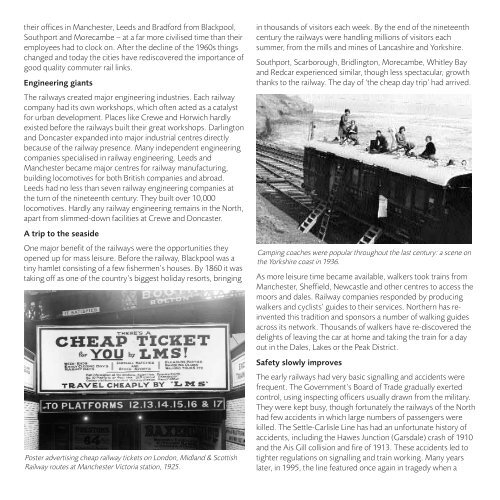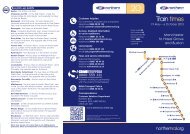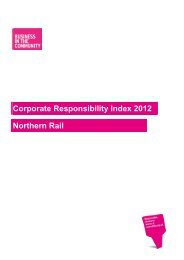Northern Heritage - Northern Rail
Northern Heritage - Northern Rail
Northern Heritage - Northern Rail
- No tags were found...
You also want an ePaper? Increase the reach of your titles
YUMPU automatically turns print PDFs into web optimized ePapers that Google loves.
their offices in Manchester, Leeds and Bradford from Blackpool,Southport and Morecambe – at a far more civilised time than theiremployees had to clock on. After the decline of the 1960s thingschanged and today the cities have rediscovered the importance ofgood quality commuter rail links.Engineering giantsThe railways created major engineering industries. Each railwaycompany had its own workshops, which often acted as a catalystfor urban development. Places like Crewe and Horwich hardlyexisted before the railways built their great workshops. Darlingtonand Doncaster expanded into major industrial centres directlybecause of the railway presence. Many independent engineeringcompanies specialised in railway engineering. Leeds andManchester became major centres for railway manufacturing,building locomotives for both British companies and abroad.Leeds had no less than seven railway engineering companies atthe turn of the nineteenth century. They built over 10,000locomotives. Hardly any railway engineering remains in the North,apart from slimmed-down facilities at Crewe and Doncaster.A trip to the seasideOne major benefit of the railways were the opportunities theyopened up for mass leisure. Before the railway, Blackpool was atiny hamlet consisting of a few fishermen’s houses. By 1860 it wastaking off as one of the country’s biggest holiday resorts, bringingPoster advertising cheap railway tickets on London, Midland & Scottish<strong>Rail</strong>way routes at Manchester Victoria station, 1925.in thousands of visitors each week. By the end of the nineteenthcentury the railways were handling millions of visitors eachsummer, from the mills and mines of Lancashire and Yorkshire.Southport, Scarborough, Bridlington, Morecambe, Whitley Bayand Redcar experienced similar, though less spectacular, growththanks to the railway. The day of ‘the cheap day trip’ had arrived.Camping coaches were popular throughout the last century: a scene onthe Yorkshire coast in 1936.As more leisure time became available, walkers took trains fromManchester, Sheffield, Newcastle and other centres to access themoors and dales. <strong>Rail</strong>way companies responded by producingwalkers and cyclists’ guides to their services. <strong>Northern</strong> has reinventedthis tradition and sponsors a number of walking guidesacross its network. Thousands of walkers have re-discovered thedelights of leaving the car at home and taking the train for a dayout in the Dales, Lakes or the Peak District.Safety slowly improvesThe early railways had very basic signalling and accidents werefrequent. The Government’s Board of Trade gradually exertedcontrol, using inspecting officers usually drawn from the military.They were kept busy, though fortunately the railways of the Northhad few accidents in which large numbers of passengers werekilled. The Settle-Carlisle Line has had an unfortunate history ofaccidents, including the Hawes Junction (Garsdale) crash of 1910and the Ais Gill collision and fire of 1913. These accidents led totighter regulations on signalling and train working. Many yearslater, in 1995, the line featured once again in tragedy when a

















